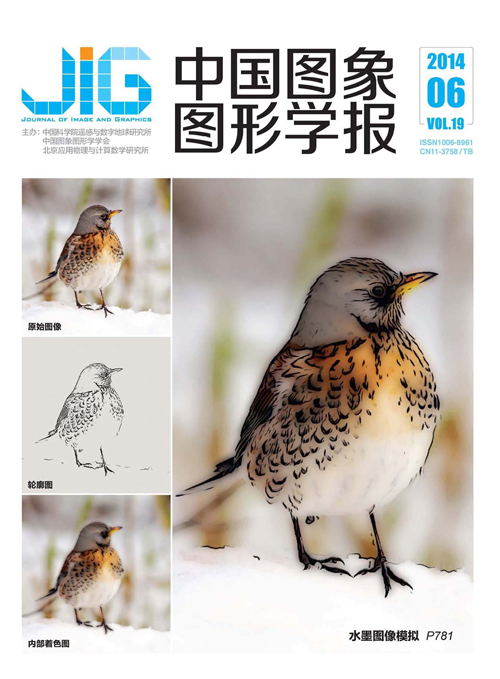
结合色度和纹理不变性的运动阴影检测
殷保才1,2, 刘羽1,2, 汪增福1,3,2(1.中国科学技术大学自动化系, 合肥 230027;2.语音及语言信息处理国家工程实验室, 合肥 230027;3.中国科学院合肥智能机械研究所, 合肥 230031) 摘 要
目的 在运动检测中,运动物体产生的阴影常常被错误地检测为运动物体本身,为了将阴影从检测结果中消除,提出一种色度不变性和纹理不变性相结合的运动阴影检测方法。方法 首先从阴影的物理模型出发,直接在RGB颜色空间利用色度不变性来获得候选阴影区域,然后根据颜色信息对候选阴影区域进行分割,对每个子区域,利用一种基于局部二值模式的指标来度量其与对应背景区域的纹理相似程度,进而判断该子区域是否是阴影,从而得到最终的检测结果。结果 在公开测试集上的实验结果表明本文方法可以有效地检测出运动阴影,相对于几种常用的阴影检测算法具有一定的优势。结论 实验结果表明,在多类复杂场景中,本文方法都能有效地将运动阴影检测出来,具有较强的鲁棒性。
关键词
Moving shadow detection by combining chromaticity and texture invariance
Yin Baocai1,2, Liu Yu1,2, Wang Zengfu1,3,2(1.Department of Automation, University of Science and Technology of China, Hefei 230027, China;2.National Engineering Laboratory for Speech and Language Information Processing, Hefei 230027, China;3.Institute of Intelligent Machines, Chinese Academy of Sciences, Hefei 230031, China) Abstract
Objective The detection of moving objects plays an important role in many image processing and computer vision applications, such as object recognition and tracking, as well as traffic surveillance. However, moving cast shadows are usually misclassified as moving objects because the moving shadows not only have the same movement as the moving objects but also have different intensity values with the background regions. It is well known that chromaticity and texture are the two most commonly used features in moving shadow detection. In this paper, by combining these two features reasonably, we propose a novel approach based on chromaticity and texture invariance to remove the shadow regions from the moving detection results. Method In our method, the moving shadows are detected not only at the pixel level, but also at the region level. When a background pixel is covered by shadow, its intensity value decreases, but the chromaticity remains the same. Therefore, we first use the chromaticity invariance at the pixel level to obtain candidate shadow regions. Chromaticity is usually used in HSV color space, which can provide a natural separation between chromaticity and luminosity. In our method, an approach applying chromaticity directly in the RGB color space is proposed, which allows for an algorithm withfewer parameters. In order to ensure that all the real shadows are included in the initial candidate shadow regions, a corresponding threshold is set conservatively in this step, which will lead to parts of the moving objects wrongly detected as shadow regions as well. To remove them from the candidate shadow regions, we first segment the candidate shadow regions into several sub-regions according to the color information. Since the moving objects and their shadows usually have different intensity values, this strategy can effectively separate the shadows from the moving objects. Then we introduce a quantitative index inspired by the local binary pattern (LBP) to measure the texture invariance of each sub-region. As regions under shadow tend to remain their textural characteristics, the real shadow regions can be finally detected in the region level. Result We choose five videos from a public dataset, which is most commonly used in moving shadow detection, to verify the effectiveness of the proposed method. The selected videos contain different scenes, indoor and outdoor, and the size of the shadow changes in a wide range. First, experiments to confirm the assumptions in this paper are conducted. Then, we compare our results with some classical and popular approaches via several objective evaluation criteria. The methods used for the comparison are chromaticity method, geometry method, physical method, small-region texture method, and large-region texture method. Experimental results demonstrate that our method can obtain good detection results and outperform other methods in terms of subjective visual perception and objective evaluation criteria. Conclusion There are three main contributions of this paper. First, we present an approach, which directly applies the chromaticity invariance in RGB color space, which makes the number of parameters less than traditional methods using the HSV color space. Second, a quantitative index inspired by the LBP is designed to measure the texture similarity between the detected candidate regions and the corresponding background regions. Compared with conventional methods that use histogram-matching approaches, the proposed method is more accurate. Third, we provide a good detection example by combining the pixel level-based method and region level-based method. In this method, color information and texture information are both fully exploited. Experimental results demonstrate that our method can successfully detect the moving shadows in various categories of scenes.
Keywords
moving object detection moving shadow detection chromaticity invariance texture invariance local binary pattern
|



 中国图象图形学报 │ 京ICP备05080539号-4 │ 本系统由
中国图象图形学报 │ 京ICP备05080539号-4 │ 本系统由